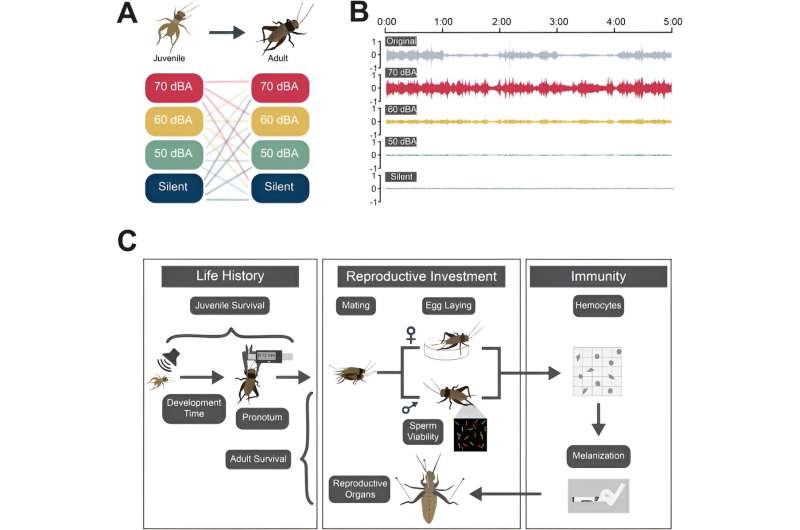
As the sun sets and the sweltering heat gives way to a balmy evening, there’s one sound that fills the air, both beloved and bothersome: the rhythmic symphony of chirping crickets. However, human-generated noise can mask the harmony of the cricket song, prompting researchers to question whether it is also drowning out the melody.
University of Denver researchers have evaluated the impact of human-generated noise on crickets. Invertebrates comprise more than 95% of all animal species on earth. Vehicular noise exposes at least 83% of land in the continental U.S., and 88% of people experience noise equivalent to constant rainfall. However, less than 4% of noise research on terrestrial organisms has focused on invertebrates.
Researchers recently published the results of this three-year study in BMC Ecology and Evolution. Here are a few takeaways:
- Under certain noise levels, the rate of survival to adulthood decreased, and the number of offspring that hatched depended on the combination of noise experiences a female had during the juvenile and adult stages.
- For example, researchers exposed the crickets to four traffic noise levels commonly experienced in their natural environment: silence, 50 decibels, 60 decibels, and 70 decibels—noting that 55 decibels are equivalent to constant rainfall. Crickets raised with noise levels at 70 decibels (like a busy street or vacuum cleaner) were 35% less likely to survive adulthood than those raised in silence.
“Noise pollution was recently associated with declines in arthropod abundance, which could drastically impact entire ecological communities of interacting organisms,” said Robin Tinghitella, principal investigator of the study and Associate Professor of Biology at DU.
“Insects that communicate with one another using sounds might be impacted by noise pollution, so we focused our work on field crickets, a group that uses airborne songs to communicate, lives near urban or urbanizing environments, and can readily hear traffic noise.”
The research team analyzed the impact of noise pollution on 15 cricket traits, discovering that the rate of survival to adulthood and the number of offspring that hatched were affected. Tinghitella suggests that human-generated noise acts as a stressor on crickets.
However, despite these effects, 13 other characteristics measured did not change depending on noise exposure, indicating that crickets are learning to live with the constant noise of humans.
Mark Mitchell, Professor of Zoological Medicine at Louisiana State University, commended the study, emphasizing the diversity and collaboration within the research team. He noted the significance of the findings in understanding the impact of human activity, such as traffic noise, on the immune and reproductive responses of invertebrates like crickets.
“The research provides important insight into the impact of anthropogenic activity (traffic noise) on the immune and reproductive responses of an invertebrate (cricket),” he said. “This research contributes to the dearth of evidence in this field and can be used to guide future planning.”
More information:
Gabrielle T. Welsh et al, Consistent traffic noise impacts few fitness-related traits in a field cricket, BMC Ecology and Evolution (2023). DOI: 10.1186/s12862-023-02190-2
Provided by
Morris Animal Foundation
Citation:
Study finds human noise negatively impacts cricket survival and reproduction (2024, May 2)
retrieved 2 May 2024
from https://phys.org/news/2024-05-human-noise-negatively-impacts-cricket.html
This document is subject to copyright. Apart from any fair dealing for the purpose of private study or research, no
part may be reproduced without the written permission. The content is provided for information purposes only.







